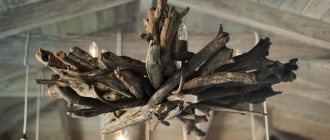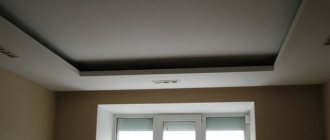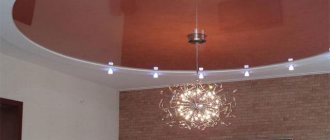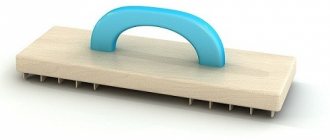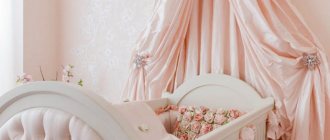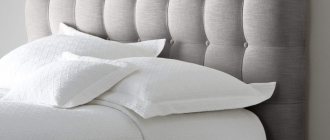If you have long been wondering how to decorate your apartment or house without significant costs funds and time, we propose to transform light sources, namely make a lampshade for floor lamp with your own hands. You probably know that a beautiful and unusual chandelier in a store is very expensive, but you don’t have to spend a lot of money to make something amazing. We will use the most common materials that you will definitely find in your household. Any lampshade begins with a frame; if you have a ready-made one, all you have to do is decorate it; if not, don’t worry, we can easily make the base ourselves.
We make a frame
Any of the elements that we will later use as decor must be attached to something. In order to quickly cope with this task we will need : thick wire, pliers, cardboard. Any frame consists of at least two rings connected by spacers. Decide on the desired shape and size of the future lampshade.
Let's consider the simplest type of frame - conical. The lower ring will have a diameter of 30 cm, and the upper one - 20 cm. To find out the length of the wire that needs to be cut, you need to multiply the desired diameter by the number “pi” (3.14), that is, 30 * 3.14 = 94.2 cm The ends of the wire must be connected and bent using pliers. The height of the spacers will determine the height of the lampshade itself. For the reliability of the design, we recommend making at least 4 transverse fasteners, which will be attached to the rings at an equal distance. It should roughly look like this:
If you are preparing a frame for a future fabric lampshade, then you need to wrap it with thick cardboard so that the fabric has something to attach to. To do this, make a pattern. Wrap the frame in newspaper, mark the line where the newspaper makes a full turn, and leave a centimeter of margin for gluing, and a line for the top and bottom. Cut off the excess and transfer the resulting sketch onto cardboard. You can attach it to the frame using a hot-melt gun with glue, do not forget to coat the joint well, and remove excess glue with a piece of cloth. Your frame is ready, you can start decorating.
Paper or cardboard lampshade
Paper is the simplest and cheapest material that can be easily transformed, has many colors and different densities. The frame wrapped in cardboard can already be used as a lampshade if you decorate it a little. It may not be solid, but have holes in the shape of butterflies, flowers, circles, hearts, diamonds and other shapes, which can then be hung from the edge of the lampshade using a thin fishing line. Using cardboard of different colors you can create smooth transitions or a contrasting composition. Such a lamp will look great in a children's room, because when it emits light, small shadows in the form of cut out figures will appear on the walls and ceiling.
You can decorate the cardboard frame with corrugated paper or muffin tins . Open one mold wider, drop a little glue into the center and place a second, more closed mold inside. You can connect three or more shapes in this way. You will end up with air outlets that need to be placed as close to each other as possible. As a result, you will have a very delicate and light lampshade, from which a soft, muted light will emanate. Paper figures glued to thin strips and secured to wire frame rings are also suitable as materials. For a more aesthetic look, use paper of different colors, which will form a smooth transition from darker shades at the bottom to lighter shades at the top. Remember that paper is not a durable material, but it is easy to replace if you get bored with the appearance of the lamp and come up with something new.
Decorations and colors
In addition to the material from which the lampshade is made, the way it is decorated also plays a role.
It could be:
- Painting . You can paint paper, wood, plastic, and even metal. You can do this yourself by purchasing a plain lampshade, or you can purchase a ready-made lamp with a pattern. When purchasing, make sure that it is professional enough that there are no smudges or bleeding colors.
Creative product
- Carving . Wooden lampshades are usually decorated with carvings. It could be a pattern, it could be a drawing, or it could be through holes. In any case, a carved lampshade usually looks lace and original.
- Engraving . An analogue of carving, which is used when decorating glass and metal, it will not be possible to carry out the engraving procedure at home; you will either have to order it from a master or buy a ready-made design. Interestingly, engraving can also be different - one is more precise, another is for larger images, the third (sandblasting method) makes the entire glass matte and leaves transparent areas on it in the form of a pattern.
- Embroidery . It is used to decorate fabric; it can also be done either by hand or purchased ready-made.
There are many embroidery techniques, you can choose according to your taste - satin stitch, cross stitch, and others, less known.
Beautiful lamp in white
- Lace . If you have a lampshade made of threads, then it is quite possible to knit it with crochet or knitting needles. It will look airy and will look great in classical styles characterized by romanticism - for example, in Provence.
- Knitting . Similar to lace, but made of thicker threads. It can be lace, or it can be dense, and then you will get an analogue of a fabric lampshade, only a little brighter and more specific looking.
- Burning out . It is used to decorate wooden lampshades; it allows you to create a design not with paint, but with the help of high temperatures. It can also be done at home if you have the appropriate tool.
Product in the form of a plate
- Stained glass . The classic method of making glass shades. It looks beautiful not only due to the pattern, but also due to the fact that light, passing through colored glass, also changes color. It is useful to remember that stained glass is more fragile than solid glass, so you should not drop such a lamp.
- Colored glass . It can be transparent or matte, but it also applies to decoration methods. The light changes as it passes through it, and it can create an interesting accent.
In addition to how the lampshade is decorated, you need to consider what color it is relative to the base:
- The same one . A lamp of one color is a nice accent that can look a little bland. If you just need an accent to match the tone of the rest of the room or a contrasting one, then this is a good solution.
Glass option
- Shades . The base is darker, the shade is lighter - this is also a classic. This lamp looks a little more interesting, but it can serve exactly the same purpose - a uniform emphasis on something.
- Contrast . The base is one color, the shade is another, contrasting to it. This creates tension, which makes the lamp look more interesting. Appropriate only in homogeneous rooms without other accents - for example, in minimalism or hi-tech. It will simply get lost in more colorful interiors.
And, of course, whether the color as a whole suits the interior greatly influences the perception.
Fabric lampshade
The choice of fabric depends on the desired luminous flux. Thicker and darker fabrics will give a muted, soft light. The chosen color of the material is also important . Green and blue shades will create cool lighting, while red, yellow, and orange will create warm lighting. Once the fabric is chosen, a pattern needs to be made. You can use the same piece of newspaper as in step 1. To make the fabric cover look more neat, sew it on a machine, then turn it inside out and put it on the frame. You can simply carefully hem the edges of the pattern, iron it and glue it to the frame with glue. In both cases, do not forget to leave some extra space for the seams.
The cover does not have to be made from a single piece; it can be multi-colored rags or a combination of plain and colored fabric. If desired, you can draw or embroider beautiful patterns on the fabric . A hand-embroidered lampshade will definitely surprise your guests. You can glue a beautiful fringe with beads along the edge or wrap it with ribbon and tie a small bow. This way you can hide minor imperfections. To make such an item look more harmonious in the room, coordinate its color with other interior items. For example, with a touch of curtains or pillows on the sofa.
Lampshade made of threads
Let's make a lampshade-ball from threads with our own hands; we will need: threads or yarn or twine, PVA glue and a regular balloon.
First, pour a large amount of glue into a bowl, then you can inflate a ball of the size you need and wind threads onto it, generously spreading it with glue.
Don't forget to leave empty space for the cartridge. You can wind the threads as you like, tightly or creating gaps and patterns.
When finished, cut the thread and secure. You can also make a rather spectacular composition from balls of different sizes.
Threads, yarn, twine
These materials will be useful to us for making a ball lampshade. Even those who are sure that needlework and crafts are not at all their element can make such a lampshade for a floor lamp with their own hands We will use a balloon or an old rubber ball as a base We will also need PVA glue, a deep bowl and a wide brush. The essence of the method is to wind threads around an inflated balloon. The color, thickness and number of threads used are purely individual. If you want to get a more textured and dense shade that will let in little light, use twine and wind until you cover almost the entire surface of the ball.
Before you start wrapping, lubricate the surface of the ball with rich hand cream or oil. You will thank yourself for this when you remove it from its dried-out lampshade. Pre-soak the selected threads in glue, adding a little water to it. Let them lie down and soak up this solution. This must be done so that the layers of wound threads not only adhere to the ball, but also stick together. Inflate the balloon to the desired size and draw a border on it at the top and bottom with a marker.
The upper border will serve as a place for the light bulb socket. There should be no threads in these places. Start wrapping from the top edge. First, carefully lay out several turns of thread at the level of the mark. You should end up with a small circle, then bring the thread to the bottom border and do the same. If you don't want to, you can do without the bottom hole. Now that you see your limits, you can wind in different directions, creating as many intersections as possible and pulling the thread a little.
Apply glue
to each layer using a brush. When you reach the desired density, cut the thread and hide its edge under the circle of the upper border. Leave your creation in a warm place until completely dry. Just do not place it near the battery under any circumstances. The flow of hot air will cause the ball to deflate faster than all the layers dry, and you will get a lampshade of any shape, but definitely not round. Once dry, puncture the ball. By the way, using threads of several colors you can achieve very interesting combinations. A composition of several such lampshades of different sizes will look very harmonious.
What could a lampshade be like?
A gifted but unclaimed coffee service can be effectively used for other purposes
Kitchens of different styles imply the use of different materials in the manufacture of decorative elements
The design of a future product largely depends on the materials for its manufacture. You can make lampshades for the kitchen yourself from any materials at hand. To make a kitchen lampshade with your own hands you can use:
- Metal, plastic and ceramic dishes;
- Cutlery;
- Newspapers, wallpaper and paper;
- Threads;
- Ribbons, lace, textiles;
- Chinese or kebab sticks;
- Milk cartons;
- Foil;
- Clothespins;
- Old audio cassettes;
- Vinyl records;
- CDs;
- Glass and plastic bottles;
- Cupcake tins;
- Knitted napkins;
- Wire and beads;
- Tennis balls;
- Old light bulbs and much more.
The lampshade for a kitchen chandelier can be made in any style that best suits the design of the kitchen, and in any technique, be it crocheting, embossing or papier-mâché.
If you are planning to radically change the appearance of a chandelier, not limited to just the lampshade, then we recommend an article on how to make a chandelier with your own hands.
Braid, ribbons, lace
This is a very romantic and delicate type of lampshade that will look great in a young girl’s room. In order to make it, a wire frame will be enough. Cover it with fabric and glue beautiful lace on top, or place lace ribbons directly on wire rings. The fabric must be chosen either in a contrasting color or to match the lace. This will look more impressive. The lace may not be located along the entire perimeter, but only along the edge, this will be even more interesting. Tulle and all kinds of ruffles and bows are suitable as additional decoration.
The most interesting thing about such lampshades is the delicate shadows that they will cast. multi-colored ribbons as the main material . To do this, fasten the edge of the first tape to the lower ring and pull it to the upper one, make one turn around it and follow it back to the lower ring. Continue in this manner until you have filled all the empty space. To avoid gaps, overlap the previous tape by at least 1/3 of its width. Carefully glue the edge of the last tape on the inside, and to hide the imperfections, make a turn along the upper and lower edges of the lampshade with a wider tape. Such a bright lampshade will resemble a rainbow and glow in different colors.
If you have knitted lace napkins and you don’t know where to put them, you can do the same with them as in point 4. Soak it in glue, place it on the ball and let it dry. They will take the shape of a sphere and will look completely different.
Where to begin?
When creating a lampshade with your own hands, keep in mind that using a regular incandescent lamp is not the best idea. It is better to opt for energy-saving light bulbs that do not heat up so much and, accordingly, do not heat nearby parts, thereby ensuring safety. In addition, they are quite economical, which allows you to save money on electricity, and are also durable.
When choosing a material for a lampshade, focus on both aesthetic properties and technical characteristics. Firstly, these must be environmentally friendly, preferably natural, bases that will not distribute unsafe substances with minimal heating.
Secondly, the lampshade should not collect a lot of dust: some surfaces, like fabric ones, are more prone to this than others. Choose an option that is easy to clean and can be easily wiped with a damp cloth. This does not apply to paper, but due to the cheapness and simplicity of the material, such a chandelier can always be replaced if necessary.
Thirdly, the chandelier should illuminate the room well without darkening it. However, for some interiors, dim lighting is more suitable: in a nursery, bedroom or living room for an intimate atmosphere. In such cases, you can show your imagination by making a lampshade that creates light patterns in the room. You, as the author, can implement any of your decisions - and this is probably the main advantage of homemade lampshades.
Lamp made of beads and artificial flowers
A very beautiful creation that requires painstaking and perseverance. You will need many colors, beads or large beads, fishing line, a needle and thread and glue. It is most convenient to place flowers on a frame with cardboard. It used to be very fashionable to decorate the walls with bouquets of artificial flowers, so you probably have them collecting dust somewhere in your boxes. And in just a few hours, or even earlier, you will look at them completely differently. Separate the buds and some petals from the stems. You can even remove the plastic holders, but then you need to secure the petals with threads so that they do not fall apart. This way the parts will fit most tightly to the cardboard and stick easily. Arrange flowers and petals on the frame, filling the entire space. It's good if there are several varieties of flowers. You can make a beautiful flower arrangement on a lampshade made of plain fabric.
Imagine that you are making a bouquet, and you yourself will understand how best to act. Along the edge of the lampshade, you can add a fringe of several beads on a fishing line, or glue them in different places on the petals. You can glue a few butterflies or a dragonfly, in general, whatever you consider necessary. And large beads strung on a nylon thread can be used as the main material. As in the example with ribbons, it is necessary to fill the entire perimeter of the frame with beads, fixing the thread alternately on the upper and lower ring.
Knitted lampshade
A very unusual and most comfortable look of our product. If you have the skills to knit various patterns yourself, then this is simply wonderful. Remember that knitting takes a lot of time , so if you want to present such an item as a gift, then start preparing in advance. There are many sets with the required number of threads and pattern patterns, just choose the appropriate size. If you haven't had time to master this skill, don't be upset. Old knitted sweaters and children's sweaters that are too small for your child will come to your aid Depending on the size and shape of the lampshade, you can even use sweater sleeves.
The top and bottom will have to be sheathed to prevent them from unraveling. Place the selected part on the lampshade, you can tie it with a ribbon on top and decorate it with decorative elements, or you can simply sew it. If you wrap yarn in the color of the lampshade and cord , which will be visible, you will get a rather cute and complete composition. Both a dense knitting made with knitting needles and a more delicate version with gaps, made by crochet, are suitable. To secure this option, use glue. Apply it pointwise to the surface of the wire rings and press. Do not neglect fabric or cardboard frames. With their help, the shape of the ceiling will be better conveyed. Complete the composition with small knitted pompoms or large beads tied with thread. Surely all your friends will be surprised to see such an interior element.
DIY lampshade ideas
For a table lamp, only frame shades are suitable - those without a frame simply have nowhere to hold it. The frame can be:
- Remove from an old lamp that has not worked for a long time. If you like to put away old things in the hope that one day they will come in handy, this solution is quite suitable for you. Simply unscrew the lampshade and remove the fabric or paper covering it from the frame.
Dimmed light for the bedroom
- Make it from wire . To do this, you need to roll a ring out of thick wire and screw the stands to it with thinner wire - at least six pieces. The result should be a semicircular basket, suitable in size for your lamp.
- Made from wire, but in a different way . To do this, you need to roll up two rings of thick wire and connect them with thin posts to form a “pipe”. For strength, you can braid it with thin wire lengthwise, but this is not necessary.
- Make it out of plastic . We cut off the top of a five-liter bottle, insert a lampshade into the neck - and now, the simplest lampshade is ready. The main thing is to check if the plastic is melting before you start leaving it for a long time.
In gold color
Then you just need to decorate the frame so that it turns into a lampshade.
You can use:
- Textile . It is simply sewn onto the frame like a cover. You can even use clothes that are no longer needed if the interior allows it - for example, if you have a grunge look.
- Paper . It is best to take a dense one, fasten it with either glue or paper clips.
- Tapes . Some kind of basket is woven on the frame.
If you are into knitting, you can cover the frame with knitted patterns.
The main thing is to make sure that nothing burns or melts, and that everything fits together. The base with a leg, the leg with a shade, and the entire lamp as a whole - with the interior that will surround it.
Lamp made from old hangers
Broken wooden hangers, or those that are long overdue for renewal, can be found in every home. Finally, you can not just throw them away, but find a more worthy use. By the way, these may not necessarily be hangers. broken slats will also work They are quite thin and have an arched shape. Before assembling such a lampshade, immediately think about its color. If you're into all things natural, simply sand the wood surface to remove any minor imperfections, then finish with a water-based varnish. If you want to make the composition multi-colored, use spray paints. Now it's time to think about how we will arrange the elements on the frame. The simplest option looks like this:
The picture shows that the metal removed , and the hangers themselves were sawn in half and simply glued to the socket. You can do it this way, or you can work a little harder and get a more interesting result. We will need a screwdriver. Remove the hooks, paint the hangers and drill a hole in one edge. Insert the wire into the resulting hole, placing the required number of hangers on it. Now fasten the edges of the wire, and insert the cartridge with the wire into the space that is formed after fastening. Place the hangers evenly with their backs facing each other and secure them in the middle with a metal tie. You will be surprised by the appearance of the finished lampshade. Making a similar lampshade for a chandelier with your own hands is not difficult and does not take long.
Bottle lampshade
Another option for a glass lampshade.
- Prepare a suitable glass bottle. Draw a straight line closer to the bottom. Using a glass cutter, cut the bottle along the line.
- We use part of the bottle with the neck. Sand the sharp edge with sandpaper.
- Pull the wire through the neck. Attach the socket and lamp from the inside.
- Repeat the operation with the intended number of bottles (for a chandelier you will need 5-7 pieces), then connect them to the frame.
- Decorate to your liking.
Curtains for the kitchen - 120 real photos of new designs. Options for the ideal combination of modern curtains in the kitchen interiorHow to diversify your home interior: DIY decor and beautiful design ideas
- How to hang curtains - step-by-step instructions with photo examples and recommendations. Exclusive curtain design solutions from experienced craftswomen
Plastic bottles, spoons
There are definitely plastic bottles of different colors in every home. So that no one even thinks that this is a product made of this material, we suggest that you take the trouble to cut the bottles into small parts in the form of leaves, flowers, butterflies or any other shapes. We used leaf shapes. Draw several templates of different sizes, trace their outlines and start cutting. When you finish cutting the required number of elements, give them a natural look. Using the blunt nose of small scissors, squeeze out the veins on each leaf. to attach parts to the frame. Either glue a wire to each element and wrap them to the frame at different levels, or glue them to a cardboard frame with glue. We advise you to give preference to the longer, but also more beautiful, first method. This way the lampshade will be more translucent, and all the details will be visible due to placement at different heights.
If this is too long and tedious for you, simply cut off the tops of the bottles, leaving 10 cm at the top, cut them into thin strips, bend them outward and secure with glue. Glue the finished flowers
There were no bottles, but there are a couple of sets of plastic spoons from the picnic that will also have a use. Let's make a pineapple lamp. For the frame we need a plastic 5-liter bottle. Carefully cut off the bottom and degrease the walls. Now let's prepare the spoons. You need to separate the handle, leaving about 1 cm. When you have cut all the spoons, start gluing them from the bottom row. Each subsequent row should overlap the previous one by about half a spoon. Try to cover the entire frame in this way, right up to the neck, so that you get neat edges that will be hidden under the cartridge. Your lampshade is ready!
Don't throw away tetrapacks
Yes, you were not mistaken, we will create real miracles, practically, from waste. Not all types of packaging are suitable for us, but only those that have a mirror surface inside. This type of lampshade will perfectly complement the interior, in which the emphasis is on various geometric shapes or where strict linear shapes predominate. You will need a lot of tetrapacks for this venture, so you will have to save up the source material for some time. The packaging should be carefully cut into one solid piece. Now we cut it into strips measuring 130x21 mm, divide it into six equal parts and fold triangles from these strips.
Now comes the most difficult part - the individual elements must somehow be combined into complex shapes. We cut the fastening tapes measuring 75x19 mm, fold them into four parts, unfold them back and use them to fasten two triangles. Next, according to the same scheme, you need to collect 108 hexagons and 12 pentagons. Don’t be alarmed, when you get the hang of it, everything will work out by itself.
You can get by with regular glue, this will make things much easier and faster. When all the elements are ready, you can assemble them into a sphere or a regular cylindrical lampshade. In the latter case, pentagons will not be needed. Just glue all the parts together. In the case of a sphere, you will have to tinker. You can inflate the ball and use it as a support when gluing elements, and then burst it and take it out through the hole. Now you can be proud of the work you've done. You definitely won’t see such a lampshade in any store, and when you turn on the lamp, the play of shadows will captivate your whole family.
Newspaper tubes
Recently, weaving products from newspaper tubes . Skillful housewives make baskets for storing various items, sew covers for them, decorate, paint and even sell them online. We thought that in this way it would be quite possible to make a beautiful lampshade for a chandelier that would look great in the hallway or dining room. We don't even need a frame, but we will need a lot of newspapers.
If you use the pages of glossy magazines, the tubes will come out much stronger. It is necessary to cut a large number of paper strips, then twist the tubes. This is much easier to do using knitting needle. The ends must be coated with PVA glue and then allowed to dry thoroughly. Try to make sure that the length of the tubes is at least 20 cm. We will need about 100 pieces to make a medium-sized lampshade. Take three tubes and cross them together, you will get a six-pointed snowflake.
This is the beginning of our ceiling. To make it more convenient to work, place something heavy on top of the intersection so as not to displace the workpiece. Place the next tube on top of one of the rays peeking out from under the weight. The lower element must be wrapped over the attached one so that it rests on the adjacent vine. Repeat this step with all the twigs sticking out. You will be weaving in a spiral pattern. When you completely go around two circles, you need to expand the diameter. To do this, instead of one twig, use two twigs folded parallel to each other. Continue weaving until you reach the required size. Cut off the excess tails with scissors, secure the edges with clothespins and treat the entire surface with glue.
When the frame is dry, use spray paint to give it the desired color and once dry, seal everything with varnish. On top you will have a cross that can be carefully cut off, thereby freeing up space for the cartridge. Instead of weaving, you can secure the tubes with glue, forming a sphere or other geometric shape.
New life for old cans
In order to make a stylish and unusual lampshade that will perfectly complement the interior with its soft, cozy light, you can use ordinary tin cans of different sizes. It is necessary to remove all labels, remove any remaining glue from the surface, wash and dry well. Next we will use a small hammer and nail to make holes on the walls. Draw the desired pattern with a marker, pour water into the jar and place in the freezer until completely frozen. This is done so that when the holes are made, the can does not become deformed . The second option to preserve the shape is to stuff it tightly with paper. All that remains is to carefully make holes and dip the finished product in hot water to remove ice. You will get small cute lampshades, from which it is recommended to create compositions. The surface can be left unchanged, or it can be painted or wrapped in thin paper.
Glass jars are also suitable for us especially if they have a non-standard shape and color. However, you can give them any color, it’s very simple. Prepare sockets and light bulbs in advance. To place them inside, carefully make holes in the lids using an opening knife. In the future you will need to replace the lamp, so give preference to screw-on cans. The hole should be equal to the diameter of the cartridge, no more. Insert the threaded part into the hole in the lid, and then screw in the light bulb. Now let's start designing the lampshades themselves. Wash and dry the jars thoroughly. Now you can paint them, paint them, cover them with beads or flowers, wrap them with colored threads or lace, in general, whatever you want. Secure the surface painted or covered with small parts with clear varnish and screw on the lids. Your lampshades are ready.
Marine lampshade
There are people who cannot live without the sea and try in every possible way to reflect their love for it in the interior of their apartment. Some people bring photo frames made of seashells, others hang pictures of the sea coast, and others cannot return from vacation without a bag of shells, which they then cannot find a use for. If you recognize yourself in this phrase, then especially for you we have prepared a small master class on making a lampshade from shells , as well as beautiful sea pebbles and everything that you couldn’t pass by. To do this, we need a frame wrapped in thick cardboard, glue and your seafood gifts. Think about the color of the lampshade in advance. If you want to leave natural shades, then simply cover all the elements with transparent varnish; if you want to add a few different shades, then use acrylic paints, and then varnish. You can paint the finished lampshade, but the paint and varnish will flow into the joints between the parts and will not come out very neatly.
Now, using a heat gun, cover all or part of the surface of the frame with shells, being careful to leave few gaps as possible . Small pebbles can be glued in places on top of the first layer, this will add volume to the finished product. Such a cute piece of furniture, with a very characteristic mood, will always remind you of pleasant moments spent on the seaside.
DIY lampshade frame made of wire: base and additions
The main types of frames are shown in the figure.
They are based on basic parts that give the product the shape of a circle, oval, square, rectangle, etc., as well as auxiliary ones. They specify the geometry of the side surface - straight lines or convex/concave. Also required are fragments that connect the lampshade to the support - the lamp leg - and do not allow the finishing materials to touch the light source.
To work you need:
- hard steel wire (copper, aluminum) with a diameter of 3...5 mm (depending on the size of the structure and the weight of finishing materials) or a thin metal strip. Individual pieces of wire can be replaced with wire mesh;
- material for decoration - fabric, natural or artificial leather, rope (thread, twine, ribbons), vine (straw, wire, newspaper tubes and other options) for braiding the frame and so on;
- tools - wire cutters, pliers and round nose pliers - for work.
When planning to make a lampshade with your own hands for a round or oval-shaped floor lamp, you must first calculate the size and number of intermediate posts. The smaller the distance between them, the rounder the design will be. Typically, for a base circle with a diameter of 150...200 mm, a step of 50...80 mm is chosen.
Having cut off the necessary pieces of wire (strips, meshes), they are bent and fastened with thinner wire or soldered (welded). For convenience, initial fixation can be done using a cable tie.
Having fastened the frame in this way, you can make sure that the resulting shape is correct and, if necessary, correct it. After this, permanent fastening is carried out.
Interesting: how to check if the wire is suitable for the job? To do this, you need to put the roughly assembled frame on its side, twist it, and throw a piece of heavy fabric over it. If no deformation has occurred, the rigidity is sufficient; if not, it is better to choose a wire with a larger diameter or from a different material. You may need to change the way you attach the parts.
To make it easier to connect the wire fragments, its ends can be bent into a ring using pliers. Treating the joints with fine-grain sandpaper (40...80 grid) will help prevent slipping.
To better understand the principles of working with wire, you should familiarize yourself with the master class on making a simple lampshade for a table lamp with your own hands from wire and fabric.
It is not necessary to use textiles to diffuse and dim the light flux. Masters successfully use the techniques of crocheting and knitting, patchwork, tatting and many others. It is interesting that all the options for braiding the frame help to hide the shortcomings in the connections of its parts.
A low light absorption coefficient is provided by lace or thin fabrics (organza, gauze, chiffon, silk, mesh), a high coefficient is provided by dense ones (velvet, brocade, thick silk, velor, linen, cotton, wool).
Important: if the frame is made not of wire, but of wooden slats (branches), it is not necessary to completely hide it behind the fabric. Carefully connected elements will become part of a unique design.
Fringe, ready-made or homemade, will help decorate the edges of the lampshade (and at the same time hide bad seams and frame). For decoration and masking imperfections on the side surface, braid or ribbon lace is suitable.
Wire braiding with beads or beads looks very impressive.
Another interesting option is to braid the frame with strips of fabric, ribbon or rope.
In addition, on a neatly made frame (wire, wood) you can place any other finishing options - from beads and spoons to chains and clothespins.
You can leave the frame without decorations by choosing lamps with a diffuser body. However, for this it is necessary to ensure maximum quality of assembly of parts and treat their surface.
Forest handsome
A very unusual and spectacular lampshade that will appeal to nature lovers. Fits well into -style interior . Its name speaks for itself, and you were not mistaken if you thought that we would use as material what we brought from the forest. More precisely, we are interested in tree branches of different thicknesses and bizarre shapes . Twigs that are too thin are not suitable; they will break during the fastening process. The length of the branches should correspond to the desired height of the lampshade. Gather enough material, because during the manufacturing process, not all sticks will definitely suit you. The most interesting thing this type of lampshade can boast of is the shadows that will be reflected on the ceiling and walls. They will create the feeling that you are in a real forest.
The branches must be washed well under hot water and dried by placing them on paper and providing access to oxygen. Dry sticks need to be refined a little. You can use a knife to cut off what you think are unnecessary knots or thin parts. Cover all elements on all sides with spray paint or just varnish. The gnarlier the branches, the more interesting the lampshade will be. We will need a regular wire frame without cardboard. We will attach the parts to it using thin wire or glue it with a heat gun, whichever is more convenient for you. Not a conical, but a cylindrical base shape . Fill in the gaps very carefully and leave as few empty spaces as possible. You can add gaps in small pieces. After complete drying, the extraordinary lampshade is ready for use. Creating a similar lampshade for a chandelier with your own hands will be fun with your children.
A sea of ideas, a variety of materials
There is such a thing as handmade. It is translated from English as a thing made with your own hands. Usually such a thing costs much more than the same thing, but made in a factory or plant. A lampshade for a chandelier or a hand-made lamp can be the main decoration of any of your rooms, be it a kitchen, bedroom or living room. An original lamp can be a good housewarming gift for your friends. A creative night light, assembled from scrap materials, such as CDs, can set an interesting light tone not only in the bedroom of a modern young girl or guy, but also in a children's room. Such lamps can be assembled, as they say, literally “on your knees.”
Night light made from old CDs
A vintage-style chandelier with forged elements or made of fabric gives the room a unique antique atmosphere. It can successfully decorate a living room, a bedroom, or a hallway.
Vintage style chandelier made of forged metal rods
When the decision has been made, and it is already clear what design the future lampshade or lamp will have, then it is necessary to select the right material. A number of things that we use in our everyday life serve as improvised material:
- Plastic bottles;
- Wool threads;
- Balloons;
- Paper;
- Cardboard;
- Wire;
- Beads;
- Cutlery;
- Cupcake pans;
- Tea cups and saucers, Glass or earthenware;
- And many many others.
Chandeliers made from plastic kitchen spoons
Here are some ideas on how to make an original lampshade for a chandelier with your own hands.
Space lamp
Many in childhood dreamed of becoming astronauts and raved about distant galaxies. If your child now sleeps and sees himself in this role, we suggest decorating his children's room to match his dreams. Stationery stores sell planet models that we will need. We will make multi-level lampshades in the form of a space system .
To do this, we will need sockets with lamps and several models of different planets. The layout must be carefully divided into two parts. Before doing this, draw a circle on top, the diameter of which coincides with the diameter of the cartridge. Then you need to remove this area as well. In its place, place the lamp socket and glue the layout back together. These steps must be done for all layouts. If you haven't found any planets, you can get by with globes of different sizes.
You can use halves, which is much more convenient, because it will be easier for you to replace the light bulb. The halves are good for making lampshades for table lamps. You can use old maps of the world , wrapping them around the frame on top of white, thick cardboard. The spirit of travel will always be present in your home and inspire you to new achievements.
When making any of the above types of lampshades, remember that all materials are fire hazardous . Especially when they are exposed to frequent heat from incandescent lamps. Therefore, place all the parts at a distance of at least 15 cm from the center of the lampshade, that is, the minimum diameter of your product should be at least 30 cm. By following this simple rule, you will protect yourself and your home from unnecessary troubles.
Tags:Lighting systems
